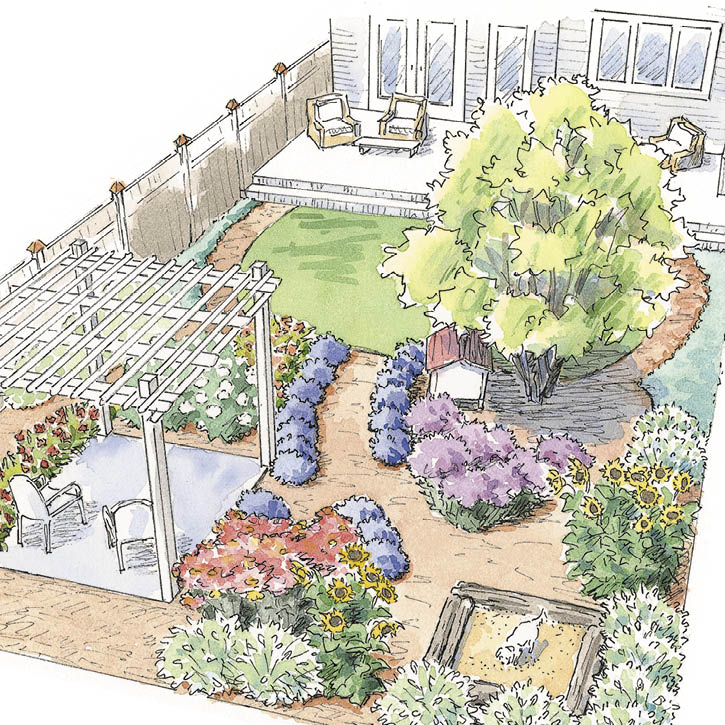Garten Design
Understanding the Basics of Garten Design
Garten design is a rich combination of aesthetics and functionality, creating an outdoor space that reflects your personality while meeting practical needs. To begin, it’s essential to consider various design elements such as plants, path layouts, and structures. A well-thought-out **garden layout** can enhance your property’s value and your enjoyment of the space. In this section, we’ll explore different garten designs, essential components, and tips for a successful layout.
/french-kitchen-garden-illustration-1457154f-eeb7cb166bc440e4a25d179e9ca429c3.jpg)
Key Elements of Effective Garten Design
Effective garden design incorporates various elements that work harmoniously together. First, consider the **plant selection**: choosing the right plants that thrive in your climate, offer color throughout the seasons, and attract pollinators is crucial. Additionally, **hardscaping** features like paths, patios, and garden borders can help define areas within your garden layout, providing structure. A well-planned garden should balance both hardscape and softscape to create an inviting atmosphere.
Garden Themes and Styles
When embarking on garten design, identifying a theme can significantly streamline the planning process. Popular styles include **formal gardens**, known for their symmetry and well-defined lines, and **informal gardens**, which emphasize natural growth patterns. Other options, such as **cottage gardens** and **Japanese Zen gardens**, offer distinct vibes. Choosing a style you connect with can make the design process enjoyable and fulfilling.
Practical Tips for Planning Your Garten Design
Planning is a fundamental step in successful garden design. Start by sketching your space and considering factors such as sunlight, soil quality, and existing structures. For instance, a **sun garden** thrives in bright sunlight, while a **shade garden** can introduce tranquility under tree canopies. It’s also essential to integrate flow and accessibility into your layout, ensuring easy navigation throughout your garden.
Creating Zones in Your Garden
Dividing your garden into zones helps in organizing planting styles and activities. Each zone can serve a specific purpose, like a **vegetable patch** for growing fresh produce, an area for **perennial flowers** for continuous blooms, or a relaxation space with seating. Creating a visually appealing transition between zones includes using pathways, borders, and varying plant heights, leading the eye from one area to another seamlessly.

Water Features in Garten Design
Integrating water features can add serenity and interest to your garden. Options include birdbaths, fountains, or even small ponds. A water feature serves as a focal point, often drawing attention and providing a habitat for wildlife. When designing water features, consider the overall style of your garden and ensure that it harmonizes with other elements. For a modern garden, a minimalist fountain may work best, while a rustic setup might benefit from a more elaborate pond.
Sustainable Practices in Garten Design
Today, sustainable gardening is a critical consideration in any garten design. Utilizing native plants, which are adapted to your region, reduces water waste and provides habitats for local wildlife. Implementing composting and rainwater collection are also beneficial practices. By prioritizing sustainability, you create not only a beautiful space but also an environmentally friendly one that enhances biodiversity.
Maintaining Your Garten Design
Regular maintenance is necessary to keep your garden looking its best, including weeding, pruning, and checking the health of your plants. Establishing a seasonal maintenance plan helps you stay organized and ensures your garden remains in optimal condition. Additionally, staying proactive about disease and pest management can help maintain the vibrancy of your garden, allowing all your design efforts to shine.
Case Study: A Successful Garten Design Transformation
To illustrate the power of effective garten design, let’s look at a hypothetical case study featuring a residential yard that transformed from an underutilized space into an inviting garden retreat. The area was initially bare, with minimal landscaping. By employing strategic zoning—designating spaces for vegetables, herbs, and flowers—the homeowners capitalized on available sunlight and soil conditions. They incorporated a **pergola** for shade and centered a **water feature** as a focal point. After completing the design, the outdoor area became a beloved family space, highlighting how thoughtful planning can turn visions into reality.
Key Takeaways
- Understanding your garden’s space and needs is essential for successful design.
- Assessing your garden style can guide plant selection and layout.
- Incorporating zones allows functional and aesthetic variety in your design.
- Implementing sustainable practices benefits both the environment and the garden’s health.
- Regular maintenance ensures your design remains effective and visually appealing.
FAQ
1. What are some common garden styles I can consider for my garten design?
There are numerous garden styles to consider. Popular options include cottage style, Japanese gardens, and contemporary designs. By selecting a style that resonates with you, you’re more likely to enjoy the gardening process and the end result, making the effort worthwhile.
2. How do I choose the right plants for my garden?
Choosing the right plants involves assessing your local climate, soil conditions, and the sun exposure levels in your garden. Opt for plants that not only suit these conditions but also reflect your aesthetic preferences. Adding a mix of natives can significantly enhance your garden’s biodiversity.
3. What are some sustainable gardening practices I can implement?
You can adopt several sustainable gardening practices, such as composting, implementing drought-resistant plants, and creating plant layers to maximize space and resources. Techniques like permaculture and integrated pest management also promote sustainability within your garten design.
4. How often should I maintain my garden for it to flourish?
Regular maintenance schedules should be established, typically weekly or bi-weekly, depending on the size of the garden and specific plants used. Seasonal tasks like mulching and pruning should also be considered, ensuring your garden remains healthy and vibrant throughout the year.
5. Can a water feature fit into almost any garden design?
Yes, water features can be incorporated into various garden designs. From ponds to small fountains, these features can enhance tranquility and aesthetics. When selecting a water feature, consider the garden’s overall style to ensure it complements other elements effectively.
